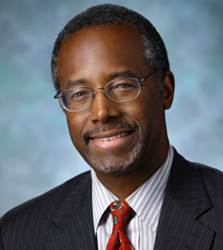
Delegate Math May Create Roadblock for Conservative GOP Candidates
One of the underappreciated elements of the presidential nomination process is the way the rules shape the outcome, or at least have the potential to do so. On the Democratic side, in 2008 the so-called “viability rule” in the Iowa caucuses may have pushed the caucus supporters of former New Mexico Gov. Bill Richardson to then-Sen. Barack Obama, bolstering his totals and helping him to win the state, as this 2008 article explains.
The same dynamic may be less likely to have an impact in 2016 with only three candidates, and the third-place candidate struggling to rise above 1 or 2 percent in the polls. But on the Republican side, the analysts over at FiveThirtyEight.com have a detailed explanation of how the GOP’s rules for awarding delegates could benefit more moderate, establishment-oriented candidates over those of Dr. Ben Carson, Sen. Ted Cruz, and businessman Donald Trump:
The GOP’s Primary Rules Might Doom Carson, Cruz And Trump
There are plenty of reasons to be cautious of national polls that show Trump and Carson leading. They may fail to screen out casual voters, for instance, and leaders at this point in past years have eventually tanked. But perhaps the biggest reason to ditch stock in these polls is that they’re simulating a national vote that will never take place.
In reality, the GOP nominating contest will be decided by an intricate, state-by-state slog for the 2,472 delegates at stake between February and June. And thanks to the Republican National Committee’s allocation rules, the votes of “Blue Zone” Republicans — the more moderate GOP primary voters who live in Democratic-leaning states and congressional districts — could weigh more than those of more conservative voters who live in deeply red zones….
A total of 832 delegates (about 34 percent of all 2,472 delegates) spanning 23 states will be awarded based on results at the congressional district level. Here’s the catch: According to the RNC’s allotment rules, three delegates are at stake in each district, regardless of the partisan lopsidedness of the seat. This creates a “rotten boroughs” phenomenon in which Blue Zone Republicans’ votes can be disproportionately valuable.
For example, three delegates are up for grabs in New York’s heavily Latino, Bronx-based 15th District, which cast just 5,315 votes for Romney in 2012. But there are also three delegates at stake in Alabama’s 6th District, which covers Birmingham’s whitest suburbs and gave Romney 233,803 votes. In other words, a GOP primary vote cast in the bluest part of the Bronx could be worth 43 times more than a vote cast in the reddest part of Alabama.
In short, a candidate who narrowly ekes out a win in a congressional district with few Republican voters will get just as many delegates as one who dominates in a heavily Republican district. And as the article also notes, the Republicans who live in districts with few GOP voters tend to be more moderate and establishment-oriented.
The effect is somewhat diluted, however, by rules that give additional delegates to states that are reliably Republican in their voting patterns and that have GOP officeholders. But the advantage for more establishment-friendly candidates is very real, as this scenario described in the piece suggests:
[I]f a hard-right candidate like Cruz dominates deeply red Southern districts in the SEC primary, a more electable candidate like Rubio could quickly erase that deficit by quietly piling up smaller raw-vote wins in more liberal urban and coastal districts.
It’s an insightful piece, but it does overlook one potential complication in the theory that may play to the benefit of Carson and Cruz, however. Many of these districts with few Republican voters have significant populations of African-American and Hispanic populations.
The previously mentioned Bronx-based 15th congressional district was won in the 2012 primary by Romney with 653 out of 1075 total votes cast, according to the New York State Board of Elections (the 5315 votes cited previously refers to the general election). Ron Paul finished second with 220 votes. Other New York-area congressional districts had even fewer GOP primary voters – 608 in the 10th, 801 in the 11th, and only 285 in the 16th.
It’s not impossible to imagine Carson drawing African-American voters in some of these areas who might not normally consider voting in a Republican primary, and the same could happen with Cruz and Hispanic voters (although that may be less likely if Sen. Marco Rubio is the establishment candidate). If they are able to draw even a few hundred voters in based on their demographic appeal, it’s easy to see this establishment advantage being blunted, and perhaps even giving new life to an anti-establishment candidate struggling against an establishment rival.
Regardless, this quirk in the election rules on the GOP side could wind up playing a determining factor in the nomination process.



